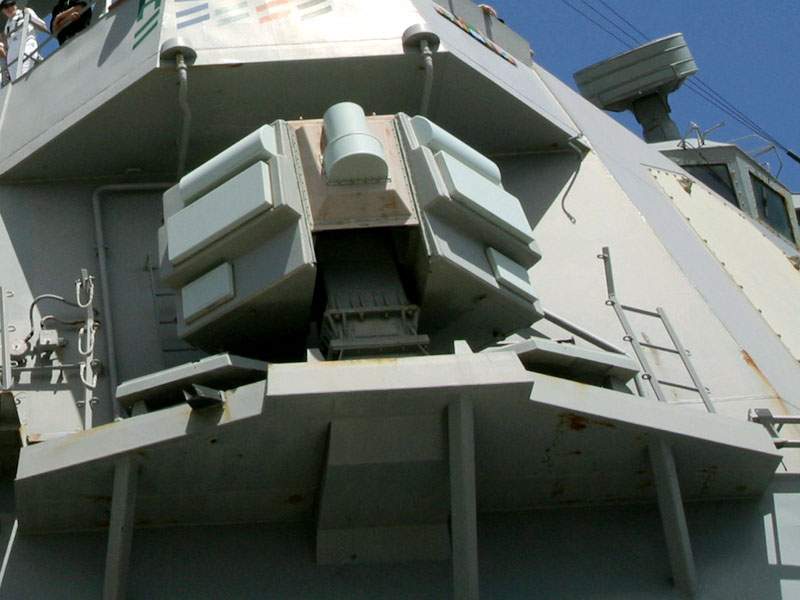
The Navy’s current shipboard electronic warfare system, the 1970s-vintage AN/SLQ-32
WASHINGTON: Our regular readers already know the bad news about electronic warfare. Russia and China are rapidly catching up to the US in jamming, spoofing, and electronic eavesdropping. Senior Pentagon officials say the technological gap between them and us is shrinking, especially on those technologies that have made the biggest difference: GPS, drones, smart weapons, satellites, command networks, and more, all of which depend on uninterrupted electronic transmissions.
The influential Center for Strategic and Budgetary Assessments has some good news. Technology close at hand — some in production, some well along in labs — could let the US surge ahead again and capture “an enduring advantage” in EW.
“This is not science fiction; it is within the state of the art of current technologies,” said CSBA co-author Mark Gunzinger this morning in a briefing on Capitol Hill.
What’s needed now, CSBA said in a study released this morning, is not new programs or massive technology investments. It’s new operational concepts and an overall strategic vision to make full use of the technology we already have.
Which brings us, of course, to the other bad news. The Defense Department doesn’t have a strategy for what to do about electronic warfare. Instead, CSBA argues, we have lots of scattered good ideas and underutilized innovations, with potentially revolutionary round pegs being forced into the square holes of outdated doctrine and bureaucracies.
Fielded or soon-to-be-fielded systems such as AESA radars on F-35s, the Navy’s Next Generation Jammer, and the SEWIP electronic warfare kit for warships all incorporate technology that could be used in far more versatile ways than current concepts take advantage of, said CSBA co-author Bryan Clark.
“These new systems are coming out with these new technologies, but they’re not necessarily being used in a way that exploits these new technologies, they’re going to be used in a way that simply mimics how the predecessor system was used,” Clark said this morning on Capitol Hill. “[So] new operational concepts are necessary to leverage the technologies we’re already fielding.”
CSBA offered it own vision and Pentagon electronic warfare experts agreed with much of it in a panel today at the Association of Old Crows annual EW conference. But that doesn’t make it easy to get to an actual Defense Department EW strategy, let alone to implement one.
“It’s very easy to write that we should do that. It’s very hard to actually do it,” Navy Capt. Michael Hutchens, who works on the inter-service Air-Sea Battle initiative, said at the Old Crows conference. From his experience on ASB, he knows that “if you’re going for integrated capabilities, at some point someone, a service, is going to lose.” And losing comes at a literal cost. It takes money to upgrade or replace your equipment to make it compatible with someone else’s, money you could spend on other priorities in your budget.
“I would echo Captain Hutchen’s comment. It is hard, but just because it’s hard doesn’t mean we shouldn’t do it,” said Lt. Col. Steven Oatman of the Army’s Cyber Center of Excellence, which also oversees Army EW. “We cannot rely on parochial service stovepipes as the de facto answer as we go forward.”
So who can advance an all-service vision? In March, Deputy Secretary of Defense Bob Work created a top-level “executive committee” to focus on electronic warfare. That’s the place to start, says CSBA.
“DoD has an opportunity here to fully empower the brand new executive committee,” Gunzinger said, “and perhaps even develop a new vision for DoD on electromagnetic spectrum warfare that could drive changes to operational concepts, that could turn around investment [and] procure new capabilities, that could begin to integrate these multiple options that are now in a stovepiped fashion working current capabilities.”
The ExCom knows it’s got work to do. Bill Conley, deputy director for electronic warfare on Frank Kendall‘s staff, was in the back of the room at today’s conference. At the committee’s last meeting, he said they decided they had to develop a new strategy. “It’s interesting to see CSBA said the exact same thing,” he said. “Give us a little time, because we will get there.”
Air Force picks Anduril, General Atomics for next round of CCA work
The two vendors emerged successful from an original pool of five and are expected to carry their drone designs through a prototyping phase that will build and test aircraft.


























